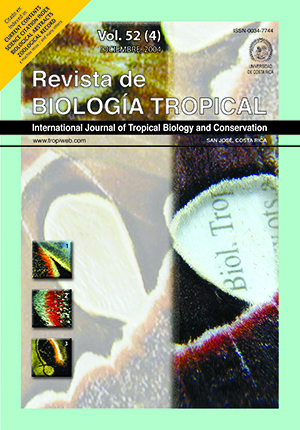Abstract
The reproductive and defecating behavior of Triatoma maculata (Erichson 1848) was studied on animals from an university culture in Venezuela. This species does not reach the importance of Rhodnius prolixus Stal 1859 as Chagas disease vector in Venezuela. This study addressed the role of defecating frequency, an index of how dangerous the animals are for the human population, and its relationship with why T. maculata is a less important vector than R. prolixus. Human blood was fed to the insects through an artificial feeding device. The 2nd and 3rd instar nymphs defecated more frequently (Id= 0.6, n=40), and our Vth instar nymphs did not complete sexual differentiation. Fertility was 55% (n=865) and fecundity 8 eggs/female/week (n=26). Egg incubation lasted 22 days (n=477). Female longevity was 51 days (n=26). Intermould time grew progressively from 35 days for 1st to 40 days for 4th instar nymphs (n=40). Mould percentage varied from 0% for Vth to 63% for 3rd instar nymphs. Mortality varied from 8% for 3rd to 100% for Vth instar nymphs. These results support evidences explaining the lesser vectorial capacity and low density of T. maculata in human domiciles, including reduced reproduction and defecation when the animal feeds on human bloodReferences
Aldana, E., E. Lizano, M. Rodríguez & A. Valderrama. 2001. Alimentación y defecación en el género Rhodnius Stal, 1859 (Hemiptera, Reduviidae) alimentados con sangre humana. Rev. Biol. Trop. 49: 693-696.
Aldana, E., E. Lizano & A. Valderrama. 2001. Efecto de la alimentación con sangre humana sobre la fecundidad, fertilidad y ciclo biológico de Rhodnius prolixus (Hemiptera, Reduviidae). Rev. Biol. Trop. 49: 689-692.
Carcavallo, R., S. Curto de Casas, I. Sherlock, I. Galíndez, J. Jurberg, C. Galvao & C. Mena Segura. 1999. Geographical distribution and alti-latitudinal dispersion of Triatominae. III: pp. 747-792. In R. Carcavallo, I. Galíndez-Girón,. J. Jurberg & H. Lent. (eds.). Atlas of Chagas disease vectors in the Americas. Fiocruz, Rio de Janeiro, Brasil.
Espinola, H., F. Rodríguez, M. de Bermúdez & R. Tonn. 1981. Informaciones sobre la biología y el ciclo de vida de Triatoma maculata (Erichson, 1848) (Hemiptera, Reduviidae, Triatominae), en condiciones de laboratorio. Bol. Dir. Malariol. San. Amb. 21:141-142.
Feliciangeli, M. & J. Rabinovich. 1985. Vital statistics of triatominae (Hemiptera: Reduviidae) under laboratory
conditions. J. Med. Entomol. 22: 43-48.
Pifano, F. 1973. La Epidemiología de la enfermedad de Chagas en Venezuela. Arch. Venez. Med. Trop. Parasitol. Med. 5: 171.
Tonn, R., M. Otero, E. Mora, H. Espinola & R. Carcavallo. 1978. Aspectos biológicos, ecológicos y distribución geográfica de Triatoma maculata (Erichson, 1848), (Hemiptera, Reduviidae), en Venezuela. Bol. Dir. Malariol. San. Amb. 18: 16-24.
Zeledón, R., R. Alvarado & L. Jirón. 1977. Observations of the feeding and defecation patterns of three triatomine
species (Hemiptera: Reduviidae). Acta Trop. 34: 65-77.
##plugins.facebook.comentarios##

This work is licensed under a Creative Commons Attribution 4.0 International License.
Copyright (c) 2004 Revista de Biología Tropical


